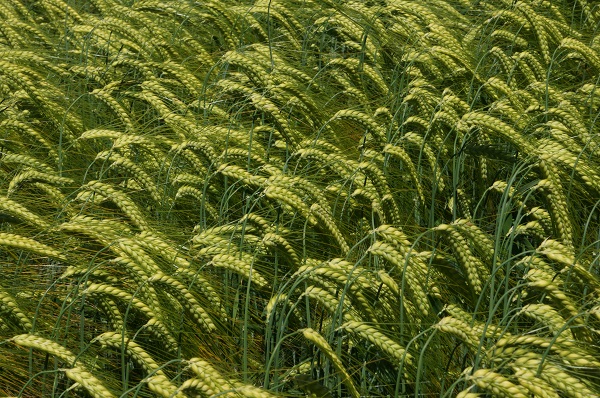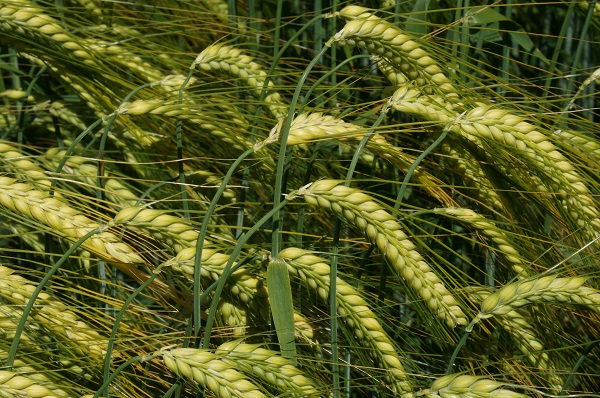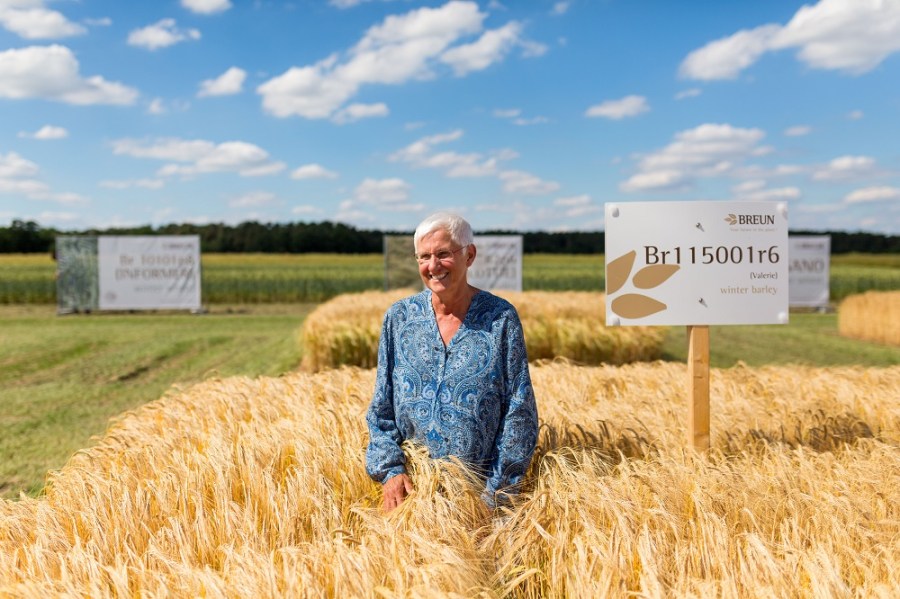As in the song, sometimes in your head you paint a picture of what a true barley should be. Well, why don’t you come on over to Valerie? CPM finds out more.
In Valerie there’s an opportunity to move onwards and upwards.
By Melanie Jenkins
Yield is often quoted as being king, but when it comes to barley, it’s specific weight that will draw growers in and make them stick to a variety – even when newer varieties boast bigger yields – hence the continued success of KWS Cassia. But after years of having nothing to contest its dominance, please step up Valerie, a high yielding two-row winter feed barley from Senova with a specific weight that will garner interest far and wide among growers.
With a specific weight of 70.2kg/hl, it’s not nabbed the top spot on the 2019 Recommended List, but it still offers one of the best grain qualities in the winter barley line-up, while combining this with a strong treated yield of 102% and untreated at 87% of control, it offers growers plenty of opportunities. Alongside this it has stiff straw, high lodging resistance and early ripening.

Valerie offers growers a high specific weight and yield combination.
Valerie is a cross of German based company, Saatzucht Breun’s and Senova breeding lines, with one parent providing the barley yellow mosaic virus type 2 resistance, while its second parent is Sandra, a major German two-row variety that has excellent grain quality, according to Heidi Jaiser, Satzucht Breun breeder. Valerie produced very good yield results in Germany in 2014 and was then sent to be trialled in the UK, Denmark, France and Austria. “Surprisingly all of these countries wanted to enter it into official trials because Valerie showed top yield results everywhere.
“Then we felt it must be something special,” she explains. “Valerie seems to be very good at adapting to different conditions.”
It’s a variety that has Senova incredibly excited. “In Valerie, we have a variety that suits the market and is easy to grow,” says Senova’s commercial director, Jeremy Taylor. “Growers have been waiting patiently for another feed variety with the desired specific weight of above 70kg/hl, so they’ll be pleased with this recommendation. Over the years, the varieties that have stuck on the market for some time are those with good specific weights, as this is what growers want to see.
“Only KWS Cassia has comparable grain quality, but Valerie offers a 4% yield advantage and better disease ratings,” points out Jeremy.
According to Jonathan Baxendale of Wynnstay, Valerie is two percentage points off the highest yielding variety on the list, but when its agronomic value is taken into account, it counterbalances that. “With pressures on gross margins on farm, untreated yield is becoming more important.”

Valerie has very low screenings, which has caught the eye of a number of merchants and agronomists.
Pearce Seeds has been looking at Valerie for a couple of years, according to Clive Tuffin. “The reason being is that we sell a lot of KWS Cassia. We’re based in Dorset, so in our part of the country we’re too far away from the malting barley market and growers tend to go for feed varieties. KWS Cassia has been so popular because of its growing quality and specific weight but we accept that it’s been outclassed in yield before, however its grain quality is what keeps people asking for it. So, we’ve been looking for a replacement with similar quality but with better yield.” Hence his enthusiasm for Valerie.
David Huish of Woodheads agrees that Valerie looks like it’ll be a really good feed barley in general. “Because of its decent untreated yields, it’s a farmer friendly variety. It also has nice straw which shouldn’t brackle – so that’s something else growers will like.”
Clive explains that Pearce Seeds now has two years of data on Valerie. “It’s always performed very well and we’ve found that its yielded akin to KWS Orwell, but with better grain quality – which is what we’re after. Though its specific weights are fractionally behind the best, it’s the closest of anything we’ve seen.”
But David Bouch of Hutchinsons, highlights that growers are cautious where specific weights are concerned. “KWS Cassia is still a sell out variety, even though there’s less and less of it around each year, but in Valerie there’s an opportunity to move onwards and upwards.”
Historically feeds have been the desired type for growing in the West and North, but they are also an integral part of rotations in other areas, explains Jeremy. “So good grain quality is very important. Valerie can offer a good entry to oilseed rape, so it’ll be good for larger areas in East Anglia, as it means farmers can get the combine into the crop early.”
Jeremy points out that Valerie does well untreated, but this doesn’t mean that it can be grown organically. “This does show it has pretty strong disease characteristics and in terms of the two-rows, it has the best untreated score.”
It boasts a 9 rating for brown rust and 6s for mildew, rhynchosporium and net blotch, which are backed up by BaYMV resistance, says Jeremy.
Varieties really have to have BaYMV resistance, comments David Huish. “We’re told it’s good to have it, but if it didn’t, that’d be a problem – it’s pretty imperative that all barleys coming through have this.”
It has no weaknesses to let it down, according to David Bouch. “A lot of barley varieties tend to be weak on mildew but again this looks good. It also seems very consistent and has shown very little variation over the years and soil types.”
However, Heidi does highlight that its tolerance to ramularia is below average, and therefore growers should take care to protect against it.
The screening levels of Valerie have really caught the attention of both David Huish and David Bouch. According to David Bouch, it’s 1% through a 2.25mm sieve and 2.5% through a 2.5mm sieve. “This is very low in terms of screenings, which is of value to the grower.”
Visually, Valerie has dark green leaf foliage in the autumn, according to Heidi. “It has quite narrow leaves but tillers well. In the spring it starts to grow early and is early to mature. It was always eye-catching in trials from a distance.”
Despite Valerie having obvious appeal for growers, there are a lot of other varieties available to them, but David Bouch thinks it offers something quite different. “There’s a very strong KWS portfolio, but these are much of a muchness, so growers aren’t getting different genetics with these. There can be a risk of putting too many eggs in one basket with too many similar traits, so there’s an argument that if farmers are growing two-rows, they should consider growing Valerie as part of their portfolio.
“So, though Valerie isn’t the highest yielding variety on the RL, it’s well up there among the pack and has characteristics that are outside of those other varieties, and is actually considerably better than many.”
The seed availability of Valerie is likely to be in relatively tight supply and already there’s been a lot of interest in it, according to Jeremy. “However, the level of interest shown by the feed industry means that the market share will increase over the seasons. We’re just finishing the spring trade, but we’re talking about autumn – we’re getting pretty good feedback from merchants all around the country.”
Jeremy recommends that growers make contact with their merchants as soon as possible. “It’s inevitable that it’ll sell out this year.” But the attributes that Valerie has could keep it on the market for a long time, he adds. “It’s one of four new varieties for Senova, but in terms of grain, Valerie has the edge.”
Clive explains that he’s expecting Valerie to eventually become Pearce Seeds’ KWS Cassia replacement. “We haven’t been pushing it yet though, as we’re still finishing off the spring.
“We’re going to have 150t of Valerie for this autumn – which will be the first time we’ve moved into it commercially, so this is just a small amount to start us off,” he adds. “But hopefully we’ll be sticking with Valerie in a few years.
“Farmers are always looking for improvement, but they’ve been reluctant to move away from Cassia because of its grain quality.”
David Huish agrees that there will be limited supply, so advises farmers to get their orders in early. “It’s an interesting variety and it’ll do well, likely playing a big part in our portfolio going forward.”
Jonathan concurs that it’s the first year Wynnstay will have Valerie available to the market properly. “We had a little supplied onto farm last year, this year there’ll be a higher tonnage but it’ll still be in extremely limited supply – we think it’ll be a sell-out variety.”
From David Huish’s perspective, he doesn’t see Valerie as taking a market share similar to KWS Gimlet or LG Flynn, but thinks it’ll be interesting to see where Valerie will sit with LG Flynn. “We would target this to a mixed grower who will use it for feed or sell it on.”
In response to current barley market stagnation, David Huish points out that locally (Selby, Yorks), crop rotations really need to be broadened. “I think barley still needs to be grown and in a big way in the area. I think it’s vital for farmers to keep growing barley as there will always be a market for it,” he explains. “Due to its good specific weight, Valerie could be an important cog in that process. It might also be a variety that draws farmers away from hybrids if they are struggling to find a market for these, especially as they don’t have the grain quality of some two-rows.”
David Bouch notes that growers can’t compare two-rows and hybrids as like with like though. “Hybrids might be grown by those with blackgrass problems as their vigour can battle the blackgrass more so than two-rows. We can’t say that Valerie is more vigorous than it’s contemporaries.”
He thinks that Valerie is likely to take its market share from some of the newer varieties. “The ones that don’t offer more yield, grain quality or as good agronomics. KWS Cassia still has a popular track record and Valerie needs to establish itself as consistent and better.” He stressed that farmers will be looking for something that will give them certain guarantees.
Overall, it stands well, has fairly early maturity, big seeds, is low on screenings and has a very good specific weight, making it a good on farm feed variety, says Jeremy. “There are a number of varieties coming on, some will stay for a long time and we think Valerie will be a stayer due to its grain quality and because it’s a good marketable variety.”
Valerie off to a good start in Leics
Andrew Wright, agronomist at Hutchinsons, has been involved with a crop of Valerie currently being grown by one of his client farmers and so far it has proven itself to have developed well.
David Duffin of J H Duffin and Son Contractors, Melton Mowbray, Leics, grows wheat, barley, oilseed rape, beans and oats and currently has a crop of Valerie in the ground. According to Andrew it is being grown as a feed for a beef suckler herd.
It was drilled quite late, around 20 Oct 2018 using a Väderstad drill at 220kg/ha behind spring barley into a good, but dry seed bed. “It emerged quickly and tillered well in the autumn,” says Andrew. “It established well and kept growing through the winter and hasn’t shown any effects from the cold winds and late frosts like some other varieties.”
There was no need for a T0 spray, but at T1 (10 Apr) it was sprayed with Bugle (fluxapyroxad), Opus Team (fenpropimorph+ epoxiconazole), Belcocel (chlormequat), Flagstaff (fluroxypyr 1-mathylheptyl) and manganese.
It will just be a case of seeing how it performs come harvest. “The farmer is pleased with the crop so far,” says Andrew.
Valerie at a Glance





